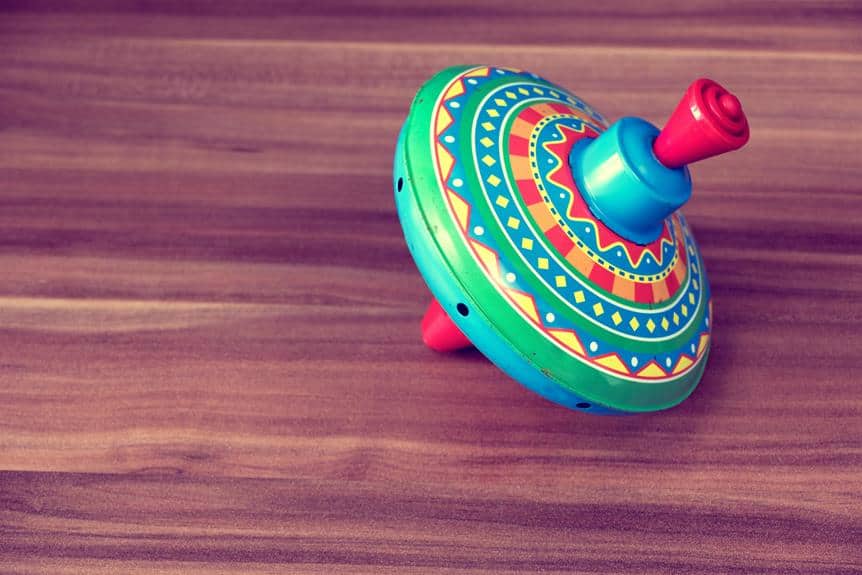Toddler Spinning Autism
As I observe a toddler twirl joyfully in circles, I am reminded of the intricate world of sensory experiences that shape young minds.
However, when these spinning motions become repetitive and intense, especially in children with autism, it opens doors to deeper insights into their unique sensory processing.
Understanding the underlying reasons behind toddler spinning in autism can reveal a world of possibilities for supporting these children in their daily lives.
Let's explore the complexities of this behavior and how we can provide meaningful interventions to enhance their well-being and development.
Key Takeaways
- Spinning behavior in toddlers can indicate sensory processing challenges in autism.
- Early recognition of spinning patterns is crucial for tailored intervention and support.
- Spinning serves as a self-regulatory tool for coping with sensory overload.
- Understanding spinning behaviors provides insights into sensory needs and communication difficulties.
Understanding Toddler Spinning Behavior

Understanding toddler spinning behavior involves recognizing its role as a self-stimulatory activity commonly observed in children with autism. For many autistic toddlers, spinning serves as a means to self-regulate and manage sensory input. The act of spinning, whether it be self-spinning or object-spinning, provides these children with a form of sensory stimulation that helps them cope with overwhelming sensory experiences.
In the context of autism, spinning behavior isn't merely a random action but a deliberate attempt to self-soothe or seek sensory feedback. By engaging in spinning activities, these toddlers are able to modulate their sensory processing and find a sense of comfort and control in their environment. It's important to understand that spinning is a tool used by autistic children to navigate the sensory challenges they face daily.
Recognizing the significance of spinning in autism diagnosis sheds light on the intricate relationship between sensory processing and self-regulation in these children. By acknowledging and supporting their spinning behavior, we can better assist them in managing their unique sensory needs.
Signs of Autism in Spinning Toddlers

As a parent or caregiver, noticing signs of autism in spinning toddlers can be concerning. Understanding the behavior patterns, communication challenges observed, and sensory processing differences are important in identifying potential autism spectrum disorder.
Seeking guidance from healthcare professionals for a thorough evaluation is key to providing the best support for spinning toddlers exhibiting signs of autism.
Spinning Behavior Patterns
Spinning behavior, whether self-induced or involving objects, can be a significant indicator of autism in toddlers, often manifesting as a repetitive and self-soothing activity. In autistic toddlers, spinning serves as a self-stimulatory behavior, helping them regulate sensory input and find comfort. Recognizing these spinning patterns early on is important as it can be a sign of sensory processing disorder or autism spectrum disorder.
Communication Challenges Observed
Upon observing spinning behavior in toddlers, one may notice specific communication challenges that serve as signs of autism in these young individuals. Lack of eye contact during spinning could indicate social-communication challenges present in toddlers with autism.
Echolalia, such as repeating words while spinning, might serve communicative purposes for children with autism who engage in this behavior. Difficulties coordinating verbal and non-verbal communication can be observed in spinning toddlers with autism, impacting their ability to effectively express themselves.
Additionally, sensory sensitivities that lead to spinning behaviors may affect language development in toddlers with autism. Furthermore, spinning could be a self-regulatory response to sensory overload, which in turn can influence the communication skills of toddlers with autism.
Sensory Processing Differences
In toddlers with autism who engage in spinning behavior, heightened sensitivity to sensory stimuli like sounds, lights, or textures can manifest as signs of sensory processing differences. For these children, spinning may serve as a way to self-regulate and manage sensory overload.
By seeking out spinning activities, toddlers with autism could be attempting to cope with their heightened sensitivity to the environment. This behavior might help them feel more in control of their sensory experiences. Sensory processing disorders can impact how children with autism respond to sensory input, making spinning behavior a potential indicator of underlying sensory issues.
Understanding these dynamics can provide insights into the unique ways in which toddlers with autism navigate their sensory world and offer strategies to support their self-regulation.
Impact of Spinning on Autistic Children

Understanding the impact of spinning on autistic children can provide valuable insights into how they self-regulate and process sensory information. Spinning plays a significant role in the sensory stimulation and self-regulation of autistic children.
Here are some key points to take into account:
- Spinning behavior in autistic children can serve as a way to modulate sensory input and maintain a sense of control.
- The vestibular system, responsible for balance and spatial orientation, is closely linked to spinning behaviors in autistic children.
- Repetitive spinning actions may help children with autism cope with sensory overload or seek additional sensory input.
- Professional evaluation is essential to determine whether spinning behaviors are within typical developmental range or require intervention.
- Understanding the individualized impact of spinning on autistic children can aid in developing personalized strategies to support their sensory needs effectively.
Strategies to Support Spinning Toddlers

As a caregiver, I understand the importance of supporting spinning toddlers with autism.
Sensory play benefits, safety considerations for spinning, and effective communication tips for parents are key aspects to explore.
Sensory Play Benefits
Exploring sensory play options tailored to their preferences can greatly benefit spinning toddlers in regulating their sensory experiences and promoting self-soothing behaviors.
- Sensory Bins: Filled with different materials like rice or sand for tactile exploration.
- Water Play: Using water tables or tubs with various objects for sensory stimulation.
- Mess-Free Sensory Bags: Offering squishy textures without the mess.
- Sensory Walks: Creating paths with different textures like grass, sand, or foam for tactile input.
- Music and Movement: Dancing or playing instruments to engage auditory and motor senses simultaneously.
These activities can support spinning toddlers in developing their sensory processing skills, fine and gross motor abilities, and overall sensory integration, providing them with valuable opportunities for growth and self-regulation.
Safety Considerations for Spinning
When supporting spinning toddlers, prioritizing safety measures is paramount to prevent accidents and promote a secure environment for their sensory exploration and self-regulation.
It's vital to supervise spinning toddlers closely to guarantee their safety and prevent any potential accidents.
Providing soft, cushioned areas for spinning activities can help reduce the risk of injuries in case of falls.
Teaching toddlers safe spinning techniques is essential to prevent dizziness or falls that may occur during the activity.
Encouraging breaks between spinning sessions is also important to avoid overstimulation or disorientation.
Consulting with occupational therapists can offer valuable guidance on supporting safe spinning behaviors in toddlers with autism, ensuring a positive and secure spinning experience for them.
Communication Tips for Parents
To support spinning toddlers effectively, parents can enhance communication by incorporating non-verbal methods such as gestures or pictures for improved interaction. Understanding the unique communication challenges faced by toddlers with autism can help create a supportive environment.
Here are some strategies to assist parents in fostering effective communication with their spinning toddlers:
- Utilize visual schedules or social stories to help toddlers grasp routines and expectations.
- Create sensory-friendly environments with calming textures and lighting to reduce spinning behaviors.
- Offer alternative sensory activities like swinging or bouncing to meet vestibular stimulation needs.
- Seek guidance from a speech-language pathologist to address communication difficulties associated with spinning behaviors.
- Encourage the use of non-verbal cues and gestures to facilitate better communication interactions.
Addressing Concerns About Toddler Spinning

Addressing concerns about toddler spinning in autism involves understanding its role as a self-regulatory behavior related to sensory processing. For autistic children, spinning behaviors can serve as a way to manage sensory input and self-regulate in overwhelming environments. It's important to recognize that these behaviors can provide comfort and help children with autism cope with stimuli that might otherwise be distressing. Occupational therapists play an important role in evaluating how spinning impacts a child's sensory stimulation and overall well-being.
When considering toddler spinning in the context of autism, it's important to look at accompanying symptoms and behaviors. These can provide valuable insights into the child's sensory needs and how spinning may be fulfilling a specific sensory requirement. Seeking professional evaluation can offer a thorough understanding of how spinning fits into the broader picture of autism diagnosis and management. By approaching toddler spinning with empathy and a research-driven mindset, caregivers and professionals can better support autistic children in their sensory processing journey.
Seeking Professional Guidance for Toddler Spinning

Understanding the role of professional guidance in evaluating toddler spinning behavior can provide valuable insights into addressing sensory processing concerns in autism. When seeking help for a child exhibiting spinning behavior, it's essential to involve experts who specialize in the autism spectrum and sensory processing disorders. Here are some key considerations to keep in mind:
- Consulting with a developmental pediatrician: A developmental pediatrician can offer specialized knowledge in child development and assess whether the spinning behavior is indicative of underlying developmental issues.
- Engaging with occupational therapists: Occupational therapists are skilled in evaluating sensory aspects of spinning behavior in toddlers and can recommend tailored interventions to support the child's needs.
- Collaborating with early intervention specialists: Early intervention specialists can provide strategies and resources to address spinning behavior in toddlers with autism, promoting early learning and development.
- Professional evaluation for tailored support: Seeking professional evaluation is essential in understanding the reasons behind toddler spinning and devising personalized support plans to meet the child's unique requirements.
Frequently Asked Questions
Is Spinning a Symptom of Autism?
Yes, spinning can be a symptom of autism. Sensory processing challenges in the autism spectrum can manifest as spinning behaviors. Understanding how these behaviors relate to sensory processing, motor skills, and developmental milestones is important for early intervention.
Is It Normal for My Toddler to Spin in Circles?
Spinning in circles as a toddler can be typical behavior for exploring balance and having fun. It helps release energy and build spatial awareness. Sometimes, it's just a playful way to navigate the world around me.
What Are the Red Flags for Autism in a 2 Year Old?
Not speaking by 16 months, lack of eye contact, and delayed motor skills are early indicators of autism in a 2-year-old. Early intervention, social communication, sensory sensitivities, repetitive behaviors, speech delay, developmental milestones, and parental concerns are crucial.
Do Kids With Autism Spin in Circles?
Yes, kids with autism may spin in circles. Sensory processing, self-stimulatory behavior, and motor coordination can influence spinning. Parenting strategies, occupational therapy, and understanding developmental milestones are crucial in supporting children with autism who spin to manage sensory overload and regulate themselves.
Conclusion
To sum up, spinning in toddlers with autism is a sensory self-stimulatory behavior that serves a purpose in self-regulation. While it may raise concerns, understanding the signs and impact is essential.
Supporting spinning toddlers with strategies and seeking professional guidance can help navigate this behavior effectively. Remember, embracing and educating ourselves on toddler spinning can lead to better support and outcomes for these children.
Let's spin with sensitivity and support for our little ones on the spectrum!







